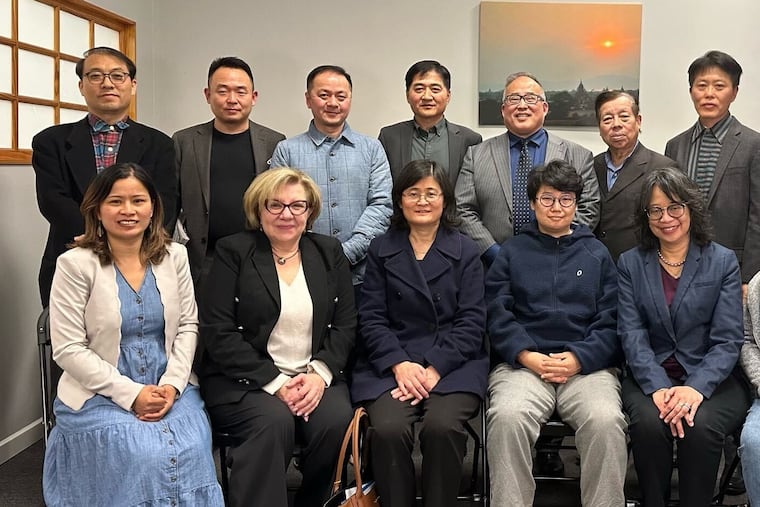Philly-area East and Central Asian community newsrooms are joining forces to boost business
The initiative aims to build a Philadelphia-based Asia news network to communicate throughout the diversified, multilingual Asian communities in the region.

A dozen Philadelphia-area newspaper and news website leaders have joined forces as the United Asian American News Media Organization to boost their businesses and the public profiles of the region’s East and Central Asian communities.
The initiative aims “to build a Philadelphia-based Asia news network and also advertising platform that mainstream organizations can utilize when it comes to communicating to the very diversified and multilingual Asian communities in the region,” said Dan Tsao, whose New Mainstream Media Co. publishes the 64-page Metro Chinese Weekly and 32-page Metro Viet News, plus the 50,000-subscriber PhillyGuide channel on WeChat.
“We want to help each other,” said Malvina Yakobashvili, a journalist from the Republic of Georgia who cofounded PhilaNewsNow in 1995. It prints 6,000 copies a week in Russian, a language common to immigrants from the 15 former Soviet republics who live in Northeast Philadelphia and nearby Bucks and Montgomery Counties.
Her organization also increasingly publishes on YouTube, Facebook, X, Instagram, TikTok, LinkedIn and Classmates.
A main focus for Jason Kang, who runs the Korean Phila Times founded by his father, “is the Sixers arena proposal. If it moves forward, we want to make sure Asian business owners have access to contracts” for services related to the facility’s planned construction and operations. The group also wants to meet with Comcast Spectacor about its proposed development at the sports complex, announced last month.
United Asian American News Media Organization would help gain powerful players’ attention, said Kang, whose paper distributes 20,000 copies of its 152-page weekly issue across the region at H-marts, Assi Plaza, doctors’ offices, restaurants, and hair salons
Tsao, Kang, and other founders credit former GOP City Council member David Oh and mayoral candidate, who now heads the Asian American Chamber of Commerce of Greater Philadelphia, for bringing the group together.
“Corporations have come to us asking to do monthly ads in the combined publications,” Oh said. “We are also talking about setting up a nonprofit to fund community education efforts and small-business apprenticeships to help the many immigrants who don’t have college degrees or connections and want to start a business” and to find candidates to succeed older business owners who have no children ready to take over.
Besides multiple Chinese, Vietnamese and Korean media and those from central Asia and Eastern Europe, the media group includes publications by immigrants from Indonesia and Cambodia.
“Now is a good time. Now more than ever,” Kang said. “We’ve waited long enough on the sidelines.”
He sees the group spreading information about local and state government assistance to businesses “that Asian Americans don’t yet know how to utilize for their benefit.”
The census estimates around 400,000 Asian Americans in the region, or 6% of the metro population, with the largest concentration in Montgomery County.
Oh noted that these residents cannot get “local Asian news” from mainstream sources. “So we tell our own stories,” he said. “And our collective story, which includes the jobs, taxes, and contributions these immigrants are making” to the Philadelphia region.
Local leaders of Epoch Times and NTD TV, national organizations associated with the anti-Communist Falun Dafa religious movement, are part of the group, Oh noted, and other publications carry immigrant and home-country stories as well as local reports.
“When [immigrants from former Soviet republics] want to know what’s going on with Uzbeks in California or New York, they go to Malvina’s articles,” Oh said.
Members hope to tap a wider market forming as immigrant businesses join the American mainstream, Oh said. “There are several Asian American-founded companies in our area alone that do hundreds of millions of dollars of annual business. Yet you don’t always see them speaking out. There is still the fear that the one who sticks his neck out risks getting their head cut off.”
Second- and third-generation Korean immigrants often work for large corporations and are less likely to speak the homeland language, Kang said. His staff may be doing more content in English in the future.
Some business owners or service professionals such as doctors, lawyers, and real estate and securities brokers remain bilingual so they can work with recent immigrants, he said.
Oh said the group has discussed translating and sharing articles of common interest among the different languages and communities.
Kang said a wide diversity of language, religion, politics, cultural views exists within the umbrella of the Asian diasporas.
“It’s important that we have a united front,” Kang said. “Each group by itself might not be so large in numbers. When we have a united front, we have a united voice.”